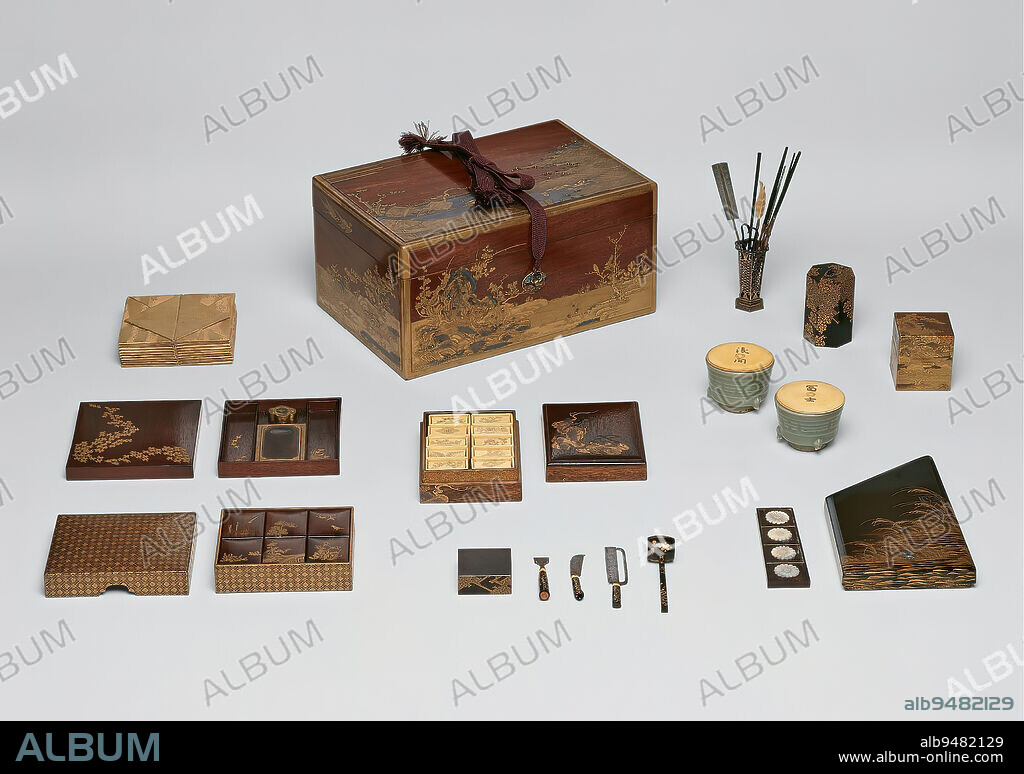alb9482129
Box and assorted implements for the incense game, 17th-18th century, Unknown Japanese, 6 × 11 7/8 × 8 in. (15.24 × 30.16 × 20.32 cm), Wood, lacquer, gold; metal utensils, Japan, 17th-18th century, Incense played a prominent role in aristocratic culture of ancient Japan. Aristocrats were expected to know how to mix aromatic imported woods with other plant products and compound them into burnable, fragrant incense. Popular ingredients included aloe, sandalwood, frankincense, pine, lily, cinnamon, and patchouli, among others. In the 1400s, this artful appreciation of incense developed further into the so-called Way of Fragrance, or kd, along with the Way of Tea (sad or chad) and the Way of Flowers (kad, better known in the West as ikebana). In incense-based games, played with the set displayed here, participants take turns smelling, appreciating, and guessing the ingredients of a certain type of incense. In one variation of the game called 'Genji Incense' or Genjik, types of incense or combinations thereof hint at chapters of The Tale of Genji.

|
Añadir a otro lightbox |
|
Añadir a otro lightbox |



¿Ya tienes cuenta? Iniciar sesión
¿No tienes cuenta? Regístrate
Compra esta imagen.
Selecciona el uso:

Descripción:
Ver traducción automática
Box and assorted implements for the incense game, 17th-18th century, Unknown Japanese, 6 × 11 7/8 × 8 in. (15.24 × 30.16 × 20.32 cm), Wood, lacquer, gold; metal utensils, Japan, 17th-18th century, Incense played a prominent role in aristocratic culture of ancient Japan. Aristocrats were expected to know how to mix aromatic imported woods with other plant products and compound them into burnable, fragrant incense. Popular ingredients included aloe, sandalwood, frankincense, pine, lily, cinnamon, and patchouli, among others. In the 1400s, this artful appreciation of incense developed further into the so-called Way of Fragrance, or kd, along with the Way of Tea (sad or chad) and the Way of Flowers (kad, better known in the West as ikebana). In incense-based games, played with the set displayed here, participants take turns smelling, appreciating, and guessing the ingredients of a certain type of incense. In one variation of the game called 'Genji Incense' or Genjik, types of incense or combinations thereof hint at chapters of The Tale of Genji.
Personas:
Crédito:
Album / quintlox
Autorizaciones:
Modelo: No - Propiedad: No
¿Preguntas relacionadas con los derechos?
¿Preguntas relacionadas con los derechos?
Tamaño imagen:
3240 x 2280 px | 21.1 MB
Tamaño impresión:
27.4 x 19.3 cm | 10.8 x 7.6 in (300 dpi)
Palabras clave:
ARISTOCRACIA • ARISTOCRATA • AZUCENA • BARNIZ • CAJA • CAMINO • CANELA • COMPUESTO • CUENTO • ESPERA • FLOR • FLORAL • FLORES • FLOWERS • FRAGANCIA • IKEBANA • INCENSARIO • INCENSE • INCIENSO • JAPON • JUEGO • LIRIO • MADERA • NOBLE • OESTE • ORO • PINO • SABER • SIGLO XVII-XVIII • TE • TRISTE • UNKNOWN JAPANESE • VARIACIÓN
 Pinterest
Pinterest Twitter
Twitter Facebook
Facebook Copiar enlace
Copiar enlace Email
Email
